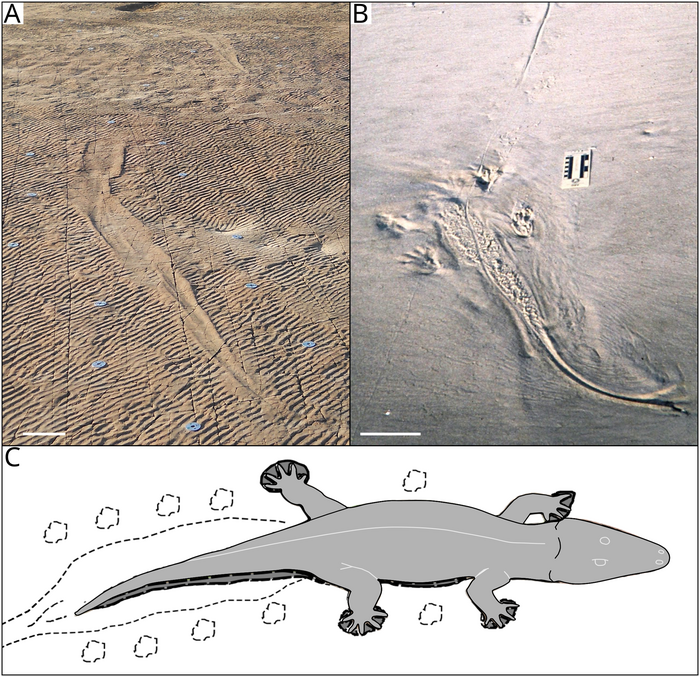Ancient 2m-long amphibians swam like crocodiles long before true crocodiles existed, according to a study published March 29, 2023 in the open-access journal PLOS ONE by David P. Groenewald of the University of the Witwatersrand, South Africa and colleagues.

Credit: Groenewald et al., 2023, PLOS ONE, CC-BY 4.0 (https://creativecommons.org/licenses/by/4.0/)
Ancient 2m-long amphibians swam like crocodiles long before true crocodiles existed, according to a study published March 29, 2023 in the open-access journal PLOS ONE by David P. Groenewald of the University of the Witwatersrand, South Africa and colleagues.
During the Late Permian Period, just over 250 million years ago, South Africa was home to rhinesuchid temnospondyls, large predatory amphibians with bodies similar to crocodiles or big salamanders. These extinct animals are known mainly from skeletal remains, but in this study, researchers describe an exceptional set of trace fossils which provide insight into how these animals moved through their environment.
The fossils were found at a site, which the researchers name the Dave Green palaeosurface, in the KwaZulu-Natal Province of South Africa, on a rock surface that was once the floor of a tidal flat or lagoon of the ancient Karoo Sea. Researchers analyzed seven body impressions (resting traces) and a number of tail-marks (swimming traces) inferred to have been made by a rhinesuchid temnospondyl that was about two meters long. Based on the spatial arrangement of these traces, the researchers interpret them to have been made by one or two animals swimming from one resting spot to another, perhaps while searching for food.
The sinuous shape of the tail-marks suggests these animals propelled themselves through the water with continuous side-to-side tail motions like modern crocodiles and salamanders. The shape of the body impressions, as well as a relative lack of footprints alongside the traces, suggests these amphibians tucked their legs against their bodies while swimming, also similar to crocodiles.
These fossils indicate an active lifestyle of swimming and bottom-walking in these ancient amphibians, an interpretation made possible by the extraordinary preservation of locomotion traces. This fossil site also preserves numerous traces from other tetrapods (four legged animals), fish, and invertebrates, and is therefore a key locality for understanding ecosystems of the Permian Period.
The authors add: “The findings of the study are significant because they help to fill in gaps in our knowledge of these ancient animals. The remarkable tracks and traces preserved on the Dave Green palaeosurface are a window onto the shoreline of the Karoo Sea roughly 255 million years ago, and provide direct evidence of how these animals moved and interacted with their environment. In addition to its remarkable scientific contribution, this study also demonstrates how important paleontological discoveries are often made by curious people bringing their findings to the attention of paleontologists.”
The locality can be explored on an interactive platform here: https://kuula.co/post/NS8d2
#####
In your coverage please use this URL to provide access to the freely available article in PLOS ONE: https://journals.plos.org/plosone/article?id=10.1371/journal.pone.0282354
Citation: Groenewald DP, Krüger A, Day MO, Penn-Clarke CR, Hancox PJ, Rubidge BS (2023) Unique trackway on Permian Karoo shoreline provides evidence of temnospondyl locomotory behaviour. PLoS ONE 18(3): e0282354. https://doi.org/10.1371/journal.pone.0282354
Author Countries: Spain, South Africa, Sweden, UK
Funding: Financial support for this project was provided by the National Research Foundation (NRF) and its African Origins Platform, GENUS (the DSI-NRF Centre of Excellence in Palaeosciences), and the Palaeontological Scientific Trust (PAST). DPG received funding from the European Union’s Horizon Europe research and innovation programme under the Marie Skłodowska-Curie actions (grant agreement: 101060666) when revising the manuscript. The funders had no role in study design, data collection and analysis, decision to publish, or preparation of the manuscript.
Journal
PLoS ONE
DOI
10.1371/journal.pone.0282354
Method of Research
Observational study
Subject of Research
Not applicable
Article Title
Unique trackway on Permian Karoo shoreline provides evidence of temnospondyl locomotory behaviour
Article Publication Date
29-Mar-2023
COI Statement
The authors have declared that no competing interests exist.




